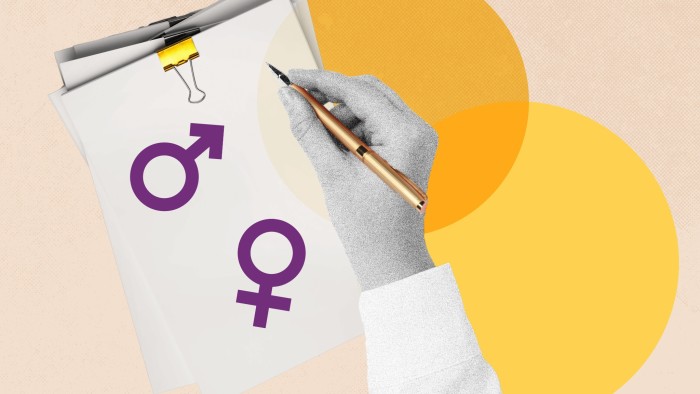Unlock the Editor’s Digest for free
Roula Khalaf, Editor of the FT, selects her favourite stories in this weekly newsletter.
The difference in pay for men and women in the UK has gradually narrowed since companies began recording it in 2017. But the way the statistic is compiled also tells a story about the gender balance of business.
This year, the gender gap in who reports the gender pay gap data closed for the first time. After years of mostly men being responsible for the data, women are now equally as likely to sign off on official submissions about the issue.
The movement towards an even gender balance is driven by more human resources workers, who are more likely to be female, taking charge of data that was previously signed off by more senior staff, according to an FT analysis.
But this does not reflect a decline in the significance of pay equality in business, according to workforce analysts. They say the shift reflects the increasingly important role HR professionals are taking in strategic areas of business, such as pay and workforce planning.
In 2017, the first year of mandatory gender pay gap reporting, the typical person listed as responsible for approving the pay gap figures was a senior leader, such as the CEO, board member or another director.
But by 2024, HR personnel were the most common employees overseeing the function. Over two-fifths of employers tasked HR staff with giving the seal of approval to pay gap figures, up from a third in 2017.
The FT’s analysis found 70 per cent of this HR group had a female first name, compared with 20 per cent of CEOs. Largely as a result, women now make up almost exactly half of all “responsible persons” on pay gap submissions.
Marks and Spencer, Nando’s and AstraZeneca are among the large organisations who have changed their responsible person from the CEO to a senior HR figure. M&S says it is “focused on offering a great place to work” and half of its board and senior leadership are women. Nando’s and AstraZeneca declined to comment.
“Pay gap calculations require a deep understanding of the regulations and high quality people data,” says Andrew Curcio, a partner in PwC’s reward and benefits team. “This work naturally fits within the teams closest to these — the people and reward functions of an organisation.”
It is also a sign that pay gap reporting has become established. Employers may have initially included senior leaders’ names to show it was being taken seriously, says Tom Heys, pay reporting lead at law firm Lewis Silkin. “But as time gone has gone on, they just put down who the actual person is who can provide the answers to any questions people may have.”
The shift follows a broader trend for the traditionally female-dominated HR function to play a more pivotal role in businesses, working closely with risk, analytics and technology teams, says Daniel Imbeault, senior director at consultancy Mercer. Organisations are increasingly “having HR at the C-suite, not a layer below,” he adds. “It’s a good time to be in HR.”
This has meant a boost for women in some companies. In 2023, almost two-thirds of HR workers in the UK and Ireland were female, according to the Chartered Institute of Personnel and Development.
Companies where HR oversaw pay gap data reported slightly smaller disparities: women at employers in this group earned 92p for every £1 men made, 2p more than where the CEO or board had the final say. However, the gap reduced by a similar amount in both groups.
The FT analysed names and job titles submitted for the person responsible in more than 68,000 submissions to the government’s gender pay gap service between 2017 and 2024. HR roles included keywords related to people, reward, talent and DEI.
Gender was categorised based on first names using an academic database.

